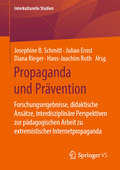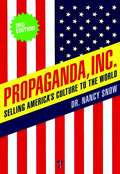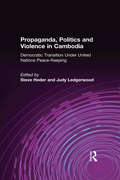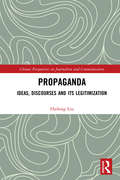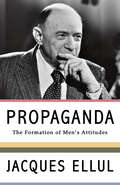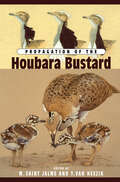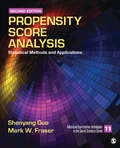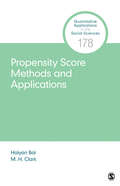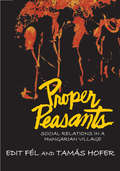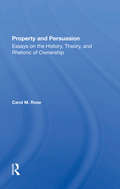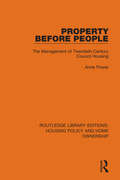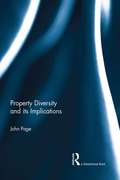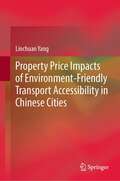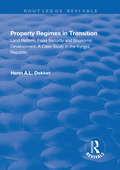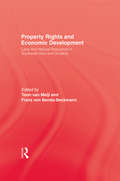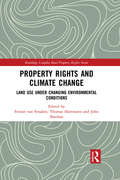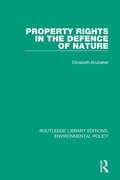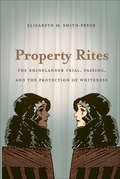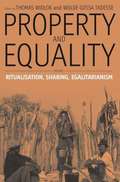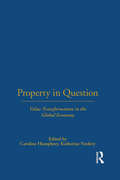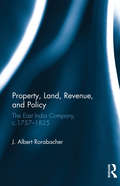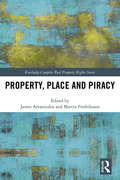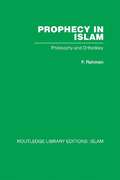- Table View
- List View
Propaganda und Prävention: Forschungsergebnisse, didaktische Ansätze, interdisziplinäre Perspektiven zur pädagogischen Arbeit zu extremistischer Internetpropaganda (Interkulturelle Studien)
by Josephine B. Schmitt Julian Ernst Diana Rieger Hans-Joachim RothÜber Propaganda extremistischer Gruppierungen zu stolpern, ist für viele Jugendliche längst alltäglicher Bestandteil ihrer Mediennutzung – und damit gesellschaftliche wie pädagogische Herausforderung. Der Band versammelt tiefgehende Einblicke in theoretische und empirische Fragestellungen der pädagogischen Arbeit mit und über extremistische Internetpropaganda. Ein Schwerpunkt liegt auf Ergebnissen des durch die Europäische Kommission geförderten Forschungsprojekts CONTRA. Zudem versammelt der Band eine Vielzahl weiterer Perspektiven auf das Phänomen extremistischer Propaganda und deren pädagogische Implikationen aus Wissenschaft und Praxis.
Propaganda, Inc.: Selling America's Culture to the World
by Herbert I. Schiller Michael Parenti Nancy SnowAn eye-opening overview of American cultural policy fully updated through the end of the Bush presidency, Propaganda, Inc. reveals how the United States Information Agency became a bureaucracy deeply distrustful of dissent, and one-way in its promotion of American corporate interests overseas.Nancy Snow spent two years inside the Agency, and here provides an insider's account of its crooked relationship to corporate interests and war--a must-read for those concerned with American propaganda and the war on terror.
Propaganda, Politics and Violence in Cambodia: Democratic Transition Under United Nations Peace-Keeping
by Steve Heder Judy LedgerwoodDescribes and analyses the propaganda and violence of the four Cambodian parties to the 1991 Paris peace agreements. This volume explores Cambodia during the UNTAC period and sets the events within the larger context of Khmer politics, history and culture.
Propaganda: Ideas, Discourses and its Legitimization (Chinese Perspectives on Journalism and Communication)
by Hailong LiuPropaganda is subjective information primarily used to influence an audience and further a political agenda. In China, it has a long history but has been most effective in modern society. What exactly is propaganda? Why does it exist and why does the public tolerate it? The book answers these questions by tracing back to the emergence and development of integrated propaganda and scientific propaganda. On this basis it focuses on the emergence of propaganda concept in China, the establishment of Kuomintang and the Communist Party of China’s propaganda concept, intellectuals and propaganda, the debate on the propaganda concept in China after 1949 as well as the emergence of Propaganda 3.0 that coordinates integrated propaganda and scientific propaganda. Setting propaganda in the framework of modernity, the book explains how various groups have legitimatized propaganda since the 20th century. From a reasonable and neutral standpoint, the author describes the confrontation among various propaganda concepts and discourses, displaying a panorama of the mutual conflicts between nations and individuals, control and freedom, ideas and bodies. Not only will scholars and students studying journalism and communication find this book interesting, but professionals working in journalism, advertising, public relations and publicity will also find it engaging and enlightening.
Propaganda: The Formation of Men's Attitudes
by Jacques EllulThis seminal study and critique of propaganda from one of the greatest French philosophers of the 20th century is as relevant today as when it was first published in 1962. Taking not only a psychological approach, but a sociological approach as well, Ellul&’s book outlines the taxonomy for propaganda, and ultimately, it&’s destructive nature towards democracy. Drawing from his own experiences fighting for the French resistance against the Vichy regime, Ellul offers a unique insight into the propaganda machine.
Propagation Of The Houbara Busta
by SaintFirst Published in 1996. Routledge is an imprint of Taylor & Francis, an informa company.
Propensity Score Analysis: Statistical Methods and Applications
by Professor Shenyang Guo Dr Mark W. FraserFully updated to reflect the most recent changes in the field, the Second Edition of Propensity Score Analysis provides an accessible, systematic review of the origins, history, and statistical foundations of propensity score analysis, illustrating how it can be used for solving evaluation and causal-inference problems. With a strong focus on practical applications, the authors explore various strategies for employing PSA, discuss the use of PSA with alternative types of data, and delineate the limitations of PSA under a variety of constraints. Unlike existing textbooks on program evaluation and causal inference, this book delves into statistical concepts, formulas, and models within the context of a robust and engaging focus on application.
Propensity Score Methods and Applications (Quantitative Applications in the Social Sciences #178)
by Haiyan Bai M. H. ClarkA concise, introductory text, Propensity Score Methods and Applications describes propensity score methods (PSM) and how they are used to balance the distributions of observed covariates between treatment conditions as a means to reduce selection bias. This new QASS title specifically focuses on the procedures of implementing PSM for research in social sciences, instead of merely demonstrating the effectiveness of the method. Using succinct and approachable language to introduce the basic concepts of PSM, authors Haiyan Bai and M. H. Clark present basic concepts, assumptions, procedures, available software packages, and step-by-step examples for implementing PSM using real-world data, with exercises at the end of each chapter allowing readers to replicate examples on their own.
Propensity Score Methods and Applications (Quantitative Applications in the Social Sciences #178)
by Haiyan Bai M. H. ClarkA concise, introductory text, Propensity Score Methods and Applications describes propensity score methods (PSM) and how they are used to balance the distributions of observed covariates between treatment conditions as a means to reduce selection bias. This new QASS title specifically focuses on the procedures of implementing PSM for research in social sciences, instead of merely demonstrating the effectiveness of the method. Using succinct and approachable language to introduce the basic concepts of PSM, authors Haiyan Bai and M. H. Clark present basic concepts, assumptions, procedures, available software packages, and step-by-step examples for implementing PSM using real-world data, with exercises at the end of each chapter allowing readers to replicate examples on their own.
Proper Peasants: Social Relations in a Hungarian Village
by Tamas HoferBased on an intensive fourteen-year study of a Hungarian peasant village, Proper Peasants greatly expands our knowledge of Eastern European social organizations with its accurate portrayal of a rapidly vanishing peasant way of life. Centering on the village of Átány in central Hungary, the study presents a dramatic account of peasant life through the turbulent centuries. It is based largely upon evidence given by villagers themselves and is a moving human story of a community with a tragic historical background and a complex, demanding present.Edit Fél and Tamás Hofer begin by locating Átány within the historical, geographical, and cultural context of Hungary as a whole. The following chapters describe units of social organization and the human relationships within and among these units. There is a special analysis of stratification and mobility within the changing structural situations of the past hundred years. Objective information about all the dimensions of village life is obtained from a comparison of Átány with nearby villages and from the use of local records. The book portrays the attempts of the community to classify, organize, and understand the universe within which lives and to control the unexpected and varied demands that have been made upon it by changing circumstances.This work makes excellent use of the strong 150-year tradition of ethnographic research in Hungary. The discussion of the warm personal relationships among the Átány people is supplemented with extensive statistical material on demographic processes, economic structure, and stratification. The picture that results is rich and fruitful, particularly so in a post-communist nation.
Property And Persuasion: Essays On The History, Theory, And Rhetoric Of Ownership
by Carol M RoseWith socialism largely discredited in recent years, the moral and legal status of private property has become an increasingly important area for discussion in contemporary political and social thought. Offering a contribution to legal theory, and to political and social philosophy, this work examines the two currently dominant traditions - those of neo-conservative utilitarianism and liberal communitarianism - emphasizing the strengths of both approaches and laying the groundwork for a theory to bridge the gap between them.
Property Before People: The Management of Twentieth-Century Council Housing
by Anne PowerOriginally published in 1987 and now re-issued with a new preface, this book examines attempts by successive individuals and governments to overcome slum conditions and homelessness, to reform landlord-tenant relations and to provide sound modern dwellings with full amenities for those who need them. Its focus is on how those responsible for public housing concentrated their energies on buildings rather than management, on property rather than people, in sharp distinction to the women who played such an innovative and humanizing role in the early days of housing reform. Efforts to resolve public housing problems are examined in a study of twenty housing estates, and of the initiatives that local authorities have taken to reverse the sometimes overwhelming decay.
Property Diversity and its Implications
by John PageProperty is more diverse than is usually assumed. Developing the concept of property diversity, this book explores the varied role of property in placed human landscapes. In acknowledging the propertied diversity about us, the book highlights the paucity of our settled contemporary assumptions of property as defined by private ownership. Challenging this universalizing model, the book analyses how this self-limiting view produces critical blind spots in modern property discourse. In response, it offers a re-conceptualization of property that matches the grounded reality of our rich and diverse relationships with land. Integrating the plurality of real property types (private, public and common) with inclusive understandings of both interest and ownership, it thus identifies and substantiates an overarching theory of property diversity. Drawing on studies from numerous jurisdictions, including the USA, New Zealand, Australia, and the UK, its analysis of property as something more – and indeed other – than a place-less abstraction provides an invaluable contribution to the contemporary law and theory of property.
Property Price Impacts of Environment-Friendly Transport Accessibility in Chinese Cities
by Linchuan YangThis book seeks to shed light on the role of environment-friendly transport accessibility in determining property prices in Chinese cities. Many environment-friendly transport modes, including walking, metro, bus rapid transit (BRT), and bus are examined. Spatial econometric models, quantile regression models, and machine learning techniques are used. This book contributes to people's understanding of the relationship between environmental-friendly transport accessibility and property prices. Moreover, it is of value to policymakers, including (1) informing urban planners/designers to plan/design cities with an adequate level of environment-friendly transport accessibility; (2) offering an evidence-based approach to implementing value capture schemes for financing investments in urban infrastructure; and (3) providing the basis for mitigating the negative externality of proximity to the transit corridor, jointly constructing comprehensive hospitals and other compatible amenities, and so forth.
Property Regimes in Transition, Land Reform, Food Security and Economic Development: A Case Study in the Kyrguz Republic
by Henri A.L. DekkerThis title was first published in 2003. Many former communist republics strive to adopt a market economy in which the privatisation of landed property is a key element. Generally, it is expected that by doing so, economic development will take off, improving food security and decreasing rural poverty. The relationship between changing land regulations, economic development and poverty is complex and yet little understood. With land reform, governments in transitional economies expect to achieve economic growth and thus alleviation of rural poverty. Nowadays, there is ample research to prove that, to be effective, land policy reforms need to be complemented with institutional reforms, and rural development activities. It puts forward a model for rapid assessment of project progress in which macro-economic indicators are applied in a systematic way to give insight to concepts such as land tenure security and food security and to provide warning signals for less-desired developments as a result of project implementation.
Property Rights & Economic Development
by VanFirst Published in 1999. Routledge is an imprint of Taylor & Francis, an informa company.
Property Rights and Climate Change: Land use under changing environmental conditions (Routledge Complex Real Property Rights Series)
by Thomas Hartmann Fennie Van Straalen John SheehanProperty Rights and Climate Change explores the multifarious relationships between different types of climate-driven environmental changes and property rights. This original contribution to the literature examines such climate changes through the lens of property rights, rather than through the lens of land use planning. The inherent assumption pursued is that the different types of environmental changes, with their particular effects and impact on land use, share common issues regarding the relation between the social construction of land via property rights and the dynamics of a changing environment. Making these common issues explicit and discussing the different approaches to them is the central objective of this book. Through examining a variety of cases from the Arctic to the Australian coast, the contributors take a transdisciplinary look at the winners and losers of climate change, discuss approaches to dealing with changing environmental conditions, and stimulate pathways for further research. This book is essential reading for lawyers, planners, property rights experts and environmentalists.
Property Rights in the Defence of Nature (Routledge Library Editions: Environmental Policy #6)
by Elizabeth BrubakerFirst published in 1995. In this study, the author provides a lively and accessible account of the failure of the legal regime to protect the environment. Elizabeth Brubaker explores how legal reliance on property rights has been useful in opposing pollution of land and water. This title will be of interest to students of Environmental Studies, as well as to all those interest in a more secure future for the environment.
Property Rites: The Rhinelander Trial, Passing, and the Protection of Whiteness
by Elizabeth M. Smith-PryorIn 1925 Leonard Rhinelander, the youngest son of a wealthy New York society family, sued to end his marriage to Alice Jones, a former domestic servant and the daughter of a "colored" cabman. After being married only one month, Rhinelander pressed for the dissolution of his marriage on the grounds that his wife had lied to him about her racial background. The subsequent marital annulment trial became a massive public spectacle, not only in New York but across the nation--despite the fact that the state had never outlawed interracial marriage. Elizabeth Smith-Pryor makes extensive use of trial transcripts, in addition to contemporary newspaper coverage and archival sources, to explore why Leonard Rhinelander was allowed his day in court. She moves fluidly between legal history, a day-by-day narrative of the trial itself, and analyses of the trial's place in the culture of the 1920s North to show how notions of race, property, and the law were--and are--inextricably intertwined.
Property and Equality, Volume 1: Ritualisation, Sharing, Egalitarianism
by Thomas Widlok Wolde Gossa TadesseThe ethnography of egalitarian social systems was first met with sheer disbelief. Today it is still hotly debated in a number of fields and has gained sophistication as well as momentum. This collection of essays on "property and equality" acknowledges this diversification by presenting research results in two complementary volumes. They bring together a wide range of authoritative researchers most of whom have worked with hunter-gatherer groups. These two volumes cover existing ethnographic and theoretical ground while maintaining a clear focus on the relation between property and equality. The book consists of the most recent work of prominent members of the original group of researchers in hunter-gatherer studies among them James Woodburn and Richard Lee, and very recent ethnography on hunter-gatherers and other egalitarian systems.
Property and Political Order in Africa
by Catherine BooneIn sub-Saharan Africa, property relationships around land and access to natural resources vary across localities, districts and farming regions. These differences produce patterned variations in relationships between individuals, communities and the state. This book captures these patterns in an analysis of structure and variation in rural land tenure regimes. In most farming areas, state authority is deeply embedded in land regimes, drawing farmers, ethnic insiders and outsiders, lineages, villages and communities into direct and indirect relationships with political authorities at different levels of the state apparatus. The analysis shows how property institutions - institutions that define political authority and hierarchy around land - shape dynamics of great interest to scholars of politics, including the dynamics of land-related competition and conflict, territorial conflict, patron-client relations, electoral cleavage and mobilization, ethnic politics, rural rebellion, and the localization and 'nationalization' of political competition.
Property in Question: Value Transformation in the Global Economy (Wenner-Gren International Symposium Series)
by Katherine VerderyHow has it come about that indigenous cultures, body parts, and sequences of musical notes are considered property? How has the movement from collective to privatized systems affected notions of property? At what point in transaction chains do native cultures, indigenous medicines, or cyberdata become objects and therefore propertized, and what are the social, economic, and ethical considerations for such transformations? Addressing these hotly contested issues and many more, Property in Question interrogates the very concept of property and what is happening to it in the contemporary world, in case studies ranging from Romania to Kazakhstan, Africa to North America. The book examines not only the changing character of the property concept, but also its ideological foundations and political usages. Authors address bio-transactions, music copyright, cyberspace, oil prospecting, debates over privatization of land and factories, and dilemmas arising with new forms of ownership of businesses. Offering a fresh perspective on contemporary economic transformation, this volume is a long overdue investigation of the power of the private property concept, as well as an exploration of how the global economy may be subtly, even invisibly, changing what property means and how we relate to it.
Property, Land, Revenue, and Policy: The East India Company, c.1757–1825
by J. Albert RorabacherFor the first century-and-a-half of its nearly 275 year existence, the English East India Company remained ostensibly a mercantile enterprise, satisfied to simply trade, competing with other European traders. In the middle of the eighteenth century, as a response to French expansion in India, the East India Company redefined itself, becoming an active participant in India’s ‘game of thrones’. Through the use of its military might, only tentatively supported by the English Crown and Parliament, the Company dominated trade, became a king-maker, and ultimately a colonial administrator over much of the Indian Subcontinent. The Company had become a state in the guise of a merchant. The Company consolidated its position in Bengal, then began to exert its power by toppling local potentates and absorbing one princely state after another. Confronted with a land system that was built on custom and tradition, and not law, with no tradition of land ownership, the British were forced to formulate a new land tenure and revenue system for India, one based on British principles of property. Permanent Settlement was the new government’s first attempt at creating a new revenue system. Through its creation, for the first time, private property rights were conferred on the formerly non-landowning zamindars. Which, as this authoritative volume notes in turn, created a land market, destabilizing the political and social structure of India irretrievably.
Property, Place and Piracy (Routledge Complex Real Property Rights Series)
by Martin Fredriksson James ArvanitakisThis book takes the concept of piracy as a starting point to discuss the instability of property as a social construction and how this is spatially situated. Piracy is understood as acts and practices that emerge in zones where the construction and definition of property is ambiguous. Media piracy is a frequently used example where file-sharers and copyright holders argue whether culture and information is a common resource to be freely shared or property to be protected. This book highlights that this is not a dilemma unique to immaterial resources: concepts such as property, ownership and the rights of use are just as diffuse when it comes to spatial resources such as land, water, air or urban space. By structuring the book around this heterogeneous understanding of piracy as an analytical perspective, the editors and contributors advance a trans-disciplinary and multi-theoretical approach to place and property. In doing so, the book moves from theoretical discussions on commons and property to empirical cases concerning access to and appropriation of land, natural and cultural resources. The chapters cover areas such as maritime piracy, the philosophical and legal foundations of property rights, mining and land rights, biopiracy and traditional knowledge, indigenous rights, colonization of space, military expansionism and the enclosure of urban space. This book is essential reading for a variety of disciplines including indigenous studies, cultural studies, geography, political economy, law, environmental studies and all readers concerned with piracy and the ambiguity of property.
Prophecy in Islam
by F RahmanOriginally published in 1958. This volume brings into focus an area of Islamic religio-philosophical thought to which relatively little attention has been paid by modern scholars of Muslim thought. The importance of the subject lies in the fact that it constitutes a central point at the confrontation of the traditional Islamic and Hellenic thought currents.
